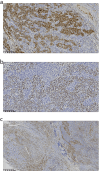Lymphoepithelioma-like carcinoma with carcinosarcoma of the endometrium: a case report and literature review
- PMID: 40761799
- PMCID: PMC12318957
- DOI: 10.3389/fimmu.2025.1636575
Lymphoepithelioma-like carcinoma with carcinosarcoma of the endometrium: a case report and literature review
Abstract
This report describes a 56-year-old female diagnosed with lymphoepithelioma-like carcinoma with carcinosarcoma of the endometrium (LELCCSE). She experienced vaginal bleeding and lower abdominal discomfort without any obvious cause following six years of menopause. She sought treatment at our hospital in Hangzhou, China. An ultrasound examination revealed a hypoechoic mass within the uterus. Subsequently, a biopsy confirmed it as lymphoepithelioma-like carcinoma (LELC) with carcinosarcoma.The patient underwent a total hysterectomy, bilateral salpingo-oophorectomy, and associated lymphadenectomy. The postoperative pathology suggested LELC complicated with carcinosarcoma and an IIC grade by the 2023 FIGO staging system. She received adjuvant chemotherapy and radiotherapy without any molecular testing due to her financial constraints. A gene which encodes the catalytic subunit of DNA polymerase epsilon(POLE) mutation was found by the retrospective molecular testing; however, no recurrence or metastasis occurred after 12 follow-up months.
Keywords: carcinosarcoma; clinicopathology; endometrium; lymphoepithelioma-like carcinoma; molecular pathology.
Copyright © 2025 Xu, Huang, Zhu, Shi and Zhou.
Conflict of interest statement
The authors declare that the research was conducted in the absence of any commercial or financial relationships that could be construed as a potential conflict of interest.
Figures




Similar articles
-
Endometrial Carcinosarcomas are Almost Exclusively of p53abn Molecular Subtype After Exclusion of Mimics.Int J Gynecol Pathol. 2024 Sep 1;43(5):506-514. doi: 10.1097/PGP.0000000000001010. Epub 2024 Feb 2. Int J Gynecol Pathol. 2024. PMID: 38303106 Free PMC article.
-
The Impact of Adjuvant Therapy on Survival and Recurrence Patterns in Women With Early-Stage Uterine Carcinosarcoma: A Multi-institutional Study.Int J Gynecol Cancer. 2016 Jan;26(1):141-8. doi: 10.1097/IGC.0000000000000561. Int J Gynecol Cancer. 2016. PMID: 26509850
-
Clinical outcomes of uterine carcinosarcoma: results of 94 patients.Int J Gynecol Cancer. 2015 Feb;25(2):279-87. doi: 10.1097/IGC.0000000000000347. Int J Gynecol Cancer. 2015. PMID: 25611900
-
Hysterectomy with radiotherapy or chemotherapy or both for women with locally advanced cervical cancer.Cochrane Database Syst Rev. 2015 Apr 7;(4):CD010260. doi: 10.1002/14651858.CD010260.pub2. Cochrane Database Syst Rev. 2015. Update in: Cochrane Database Syst Rev. 2022 Aug 22;8:CD010260. doi: 10.1002/14651858.CD010260.pub3. PMID: 25847525 Updated.
-
Hormone replacement therapy for women previously treated for endometrial cancer.Cochrane Database Syst Rev. 2018 May 15;5(5):CD008830. doi: 10.1002/14651858.CD008830.pub3. Cochrane Database Syst Rev. 2018. PMID: 29763969 Free PMC article.
References
Publication types
MeSH terms
Substances
LinkOut - more resources
Full Text Sources

